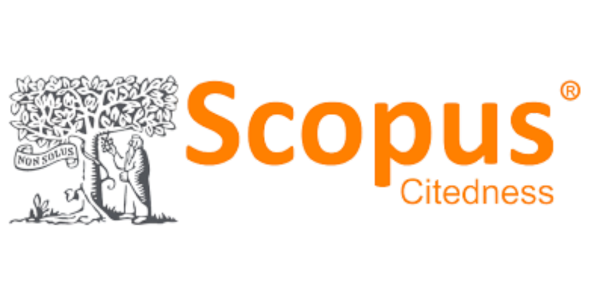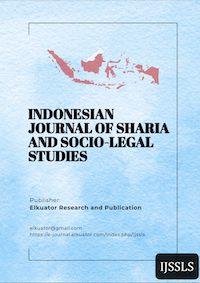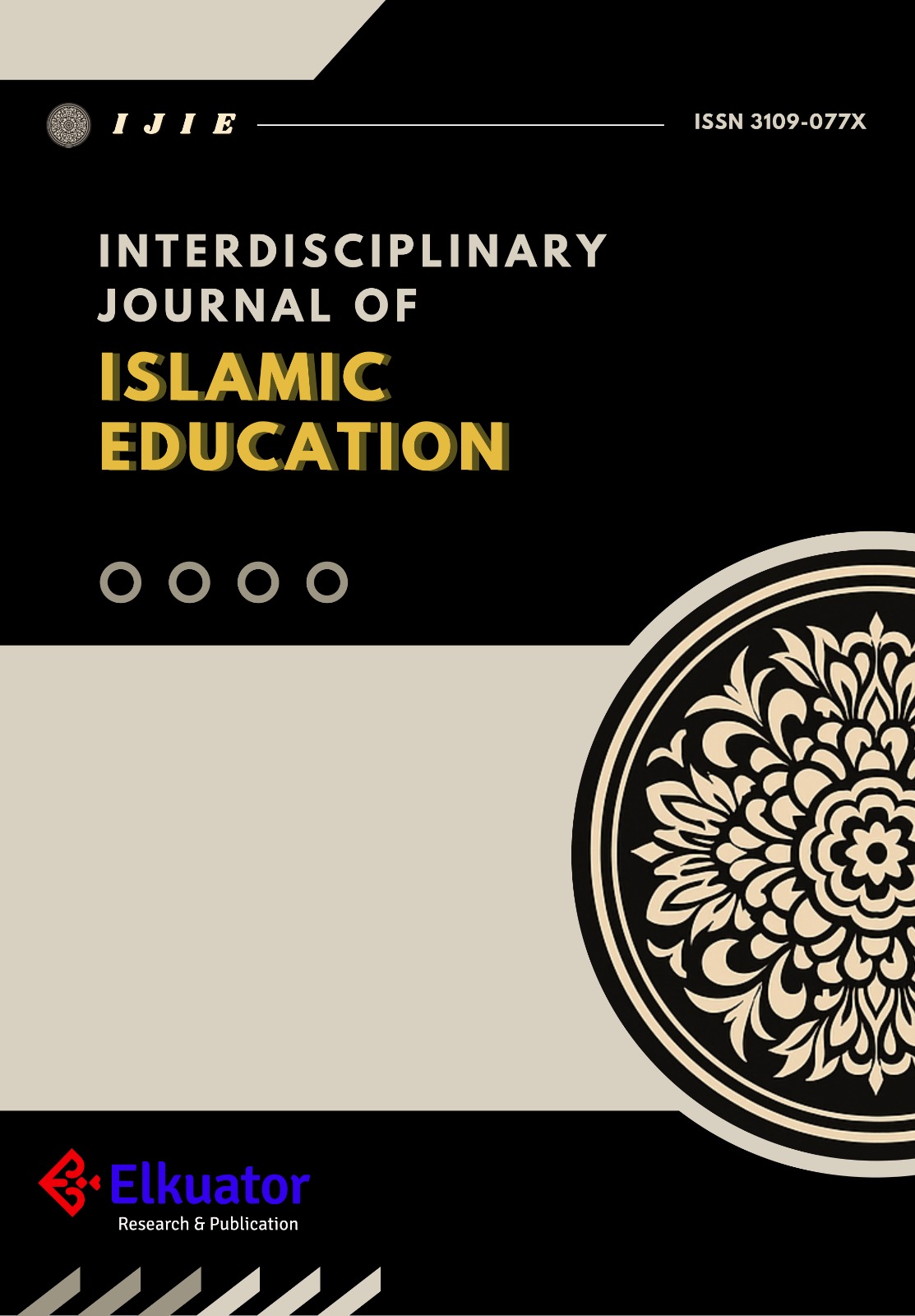From Sanad to Syntax: The Disruption of Islamic Hermeneutics by Qur’anGPT
DOI:
https://doi.org/10.24260/basmala.1.1.19Keywords:
Qur’anGPT, Hermeneutika Digital, Tafsir Al-Qur’an, Artificial Intelligence, Otoritas KeagamaanAbstract
Artificial Intelligence (AI) is increasingly encroaching upon domains once considered the exclusive purview of human cognition, including the interpretation of religious texts. While existing scholarship has explored the ethical and legal permissibility of AI within Islamic contexts, relatively little attention has been paid to how AI technologies—such as Qur’anGPT—are reshaping interpretive authority and hermeneutical methodologies. This article addresses that gap by critically examining Qur’anGPT as a case study of digital interpretive agency within contemporary Islam. This study employs a qualitative, literature-based methodology that integrates theoretical frameworks from digital hermeneutics with the sociology of Islamic knowledge. It is further complemented by a textual analysis of user interactions with Qur’anGPT. The findings suggest that Qur’anGPT functions not merely as a technological tool but as an epistemic actor, mediating Qur’anic meaning, shaping user perceptions, and reconfiguring traditional dynamics between scripture, scholars, and the community. Its algorithmic architecture and linguistic output indicate an emerging shift toward decentralized and democratized models of religious authority. However, this shift also raises critical concerns regarding interpretive reductionism, algorithmic bias, and the diminishing authority of classical epistemological frameworks, particularly those grounded in sanad and ijtihād. The study argues that while Qur’anGPT significantly improves access to Qur’anic texts, it may oversimplify complex theological discourses. Therefore, AI should be utilized as a supplementary tool—not as a replacement—for human interpretive judgment. The article concludes by proposing an ethical-theoretical framework for evaluating AI’s role in Islamic exegesis and presents implications for scholars, technologists, and religious institutions engaged at the intersection of Islam and digital innovation.
[Kecerdasan Buatan (AI) semakin merambah ke dalam domain yang dulunya dianggap sebagai ranah eksklusif kognisi manusia, termasuk dalam interpretasi teks-teks agama. Meskipun penelitian yang ada telah mengeksplorasi kelayakan etis dan hukum AI dalam konteks Islam, perhatian yang relatif sedikit telah diberikan pada bagaimana teknologi AI—seperti Qur’anGPT—mengubah otoritas interpretatif dan metodologi hermeneutika. Artikel ini membahas kesenjangan tersebut dengan secara kritis mengkaji Qur’anGPT sebagai studi kasus agensi interpretatif digital dalam Islam kontemporer. Studi ini menggunakan metodologi kualitatif berbasis literatur yang mengintegrasikan kerangka teoretis dari hermeneutika digital dengan sosiologi pengetahuan Islam. Selain itu, studi ini dilengkapi dengan analisis tekstual terhadap interaksi pengguna dengan Qur’anGPT. Temuan tersebut menunjukkan bahwa Qur’anGPT berfungsi tidak hanya sebagai alat teknologi, tetapi juga sebagai aktor epistemik, yang memediasi makna Qur’an, membentuk persepsi pengguna, dan mengubah dinamika tradisional antara kitab suci, ulama, dan komunitas. Arsitektur algoritmik dan keluaran linguistiknya menunjukkan adanya pergeseran yang muncul menuju model otoritas religius yang terdesentralisasi dan terdemokratisasi. Namun, pergeseran ini juga menimbulkan kekhawatiran kritis mengenai reduksionisme interpretatif, bias algoritmik, dan berkurangnya otoritas kerangka epistemologis klasik, terutama yang didasarkan pada sanad dan ijtihād. Studi ini berpendapat bahwa meskipun Qur’anGPT secara signifikan meningkatkan akses ke teks-teks Qur’an, ia mungkin menyederhanakan diskursus teologis yang kompleks. Oleh karena itu, AI harus digunakan sebagai alat tambahan—bukan sebagai pengganti—untuk penilaian interpretatif manusia. Artikel ini diakhiri dengan mengusulkan kerangka etika-teoritis untuk mengevaluasi peran AI dalam eksgesis Islam dan menyajikan implikasi bagi para cendekiawan, teknolog, dan institusi keagamaan yang terlibat di persimpangan Islam dan inovasi digital.
References
Abbott, R. The Reasonable Robot: Artificial Intelligence and the Law. Edited by 1st ed. Cambridge University Press, 2020. https://doi.org/10.1017/9781108631761.
Adel, B., M. C. E. Meftah, A. Laouid, and M. Hammoudeh. “Machine Learning to Classify Religious Communities and Detect Extremism on Social Networks: ML to CRCs and DE Through Text Tweets on SNs.” International Journal of Organizational and Collective Intelligence 12, no. 1 (2022): 1–19. https://doi.org/10.4018/IJOCI.311093.
Alharbi, A., M. Taileb, and M. Kalkatawi. “Deep Learning in Arabic Sentiment Analysis: An Overview.” Journal of Information Science 47, no. 1 (2021): 129–40. https://doi.org/10.1177/0165551519865488.
Alkhouri, K. I. “The Role of Artificial Intelligence in the Study of the Psychology of Religion.” Religions 15, no. 3 (2024): 290. https://doi.org/10.3390/rel15030290.
Amedior, N. C. “Ethical Implications of Artificial Intelligence in the Healthcare Sector.” Advances in Multidisciplinary and Scientific Research Journal Publication 36 (2023): 1–12. https://doi.org/10.22624/AIMS/ACCRABESPOKE2023P1.
Baker, D. J., and P. H. Robinson, eds. Artificial Intelligence and the Law: Cybercrime and Criminal Liability. Routledge, Taylor & Francis Group, 2021.
Boddington, P. Towards a Code of Ethics for Artificial Intelligence. Springer, 2017. https://doi.org/10.1007/978-3-319-60648-4.
Bowie, R. A., F. Panjwani, and K. Clemmey. “A Meta Approach to Texts in Religious Education: Researching Teachers’ Engagement with Sacred Text Scholarship in English Secondary Schools.” British Journal of Religious Education 44, no. 3 (2022): 271–80. https://doi.org/10.1080/01416200.2022.2054773.
Bunt, G. R. Islam in the Digital Age: E-Jihad, Online Fatwas and Cyber Islamic Environments. Pluto Press, 2015. https://doi.org/10.2307/j.ctt18fs6ck.
Dreyfus, H. L. “Why Heideggerian AI Failed and How Fixing It Would Require Making It More Heideggerian.” Artificial Intelligence 171, no. 18 (2007): 1137–60. https://doi.org/10.1016/j.artint.2007.10.012.
Elmahjub, E. “Artificial Intelligence (AI) in Islamic Ethics: Towards Pluralist Ethical Benchmarking for AI.” Philosophy & Technology 36, no. 4 (2023): 73. https://doi.org/10.1007/s13347-023-00668-x.
Emon, A. M., M. Ellis, and B. Glahn, eds. Islamic Law and International Human Rights Law. Oxford University Press, 2012. https://doi.org/10.1093/acprof:oso/9780199641444.001.0001.
Gadamer, Hans-Georg. Truth and Method. Crossroad, 1989.
Greek, J. Artificial Intelligence: Clever Computers and Smart Machines. Rosen Publishing Group, 2017.
Hallaq, W. B. A History of Islamic Legal Theories: An Introduction to Sunni Usul al-Fiqh. Cambridge University Press, 1997. https://doi.org/10.1017/CBO9780511801266.
Harari, Y. N. “Reboot for the AI Revolution.” Nature 550, no. 7676 (2017): 324–27. https://doi.org/10.1038/550324a.
Heidegger, Martin. Being and Time. Blackwell, 1967.
Ihde, D. Bodies in Technology. University of Minnesota Press, 2002.
Iordan, M. C., T. Giallanza, C. T. Ellis, N. M. Beckage, and J. D. Cohen. “Context Matters: Recovering Human Semantic Structure from Machine Learning Analysis of Large‐Scale Text Corpora.” Cognitive Science 46, no. 2 (2022): e13085. https://doi.org/10.1111/cogs.13085.
Jackson, J. C., and K. C. Yam. “The In-Credible Robot Priest and the Limits of Robot Workers.” Scientific American, n.d. https://www.scientificamerican.com/article/the-in-credible-robot-priest-and-the-limits-of-robot-workers/.
Jinan, M. “New Media Dan Pergeseran Otoritas Keagamaan Islam Di Indonesia.” Jurnal Lektur Keagamaan 10, no. 1 (2012): 1. https://doi.org/10.31291/jlk.v10i1.178.
Jorgensen, T. J. Spark: The Life of Electricity and the Electricity of Life. Princeton University Press, 2021.
Khisni, H. A. Metode Ijtihad & Istimbad. Unissula Press, 2018.
Kimmerle, Friedrich D. E. Schleiermacher Edited by Heina, Translated by James Duke, and and Jack Forstman, eds. Hermeneutics: The Handwritten Manuscripts. AAR Religion in Translation. Oxford, New York: Oxford University Press, 1978.
Liu, Albert Chun Chen, Oscar Ming Kin Law, and Iain Law. Understanding Artificial Intelligence: Fundamentals and Applications. 1st ed. Wiley, 2022. https://doi.org/10.1002/9781119858393.
Mahsun, M. “Rekonstruksi Pemikiran Hukum Islam Melalui Integrasi Metode Klasik Dengan Metode Saintifik Modern.” Al-Ahkam 1, no. 25 (2015): 1. https://doi.org/10.21580/ahkam.2015.1.25.191.
Masrur, M. “Uni Emirat Arab Meluncurkan Aplikasi Mufti Virtual | Bincang Syariah.” BincangSyariah | Portal Islam Rahmatan lil Alamin, 2019. https://bincangsyariah.com/headline/uni-emirat-arab-meluncurkan-aplikasi-mufti-virtual/.
Media, K. C. “NU: Haram Minta Fatwa Ke ‘Artificial Intelligence.’” KOMPAS.com, 2023. https://nasional.kompas.com/read/2023/09/19/15551621/nu-haram-minta-fatwa-ke-artificial-intelligence.
Nawawy, M. el-, and S. Khamis. Islam Dot Com. Palgrave Macmillan US, 2009. https://doi.org/10.1057/9780230622661.
Nilsson, N. J. Artificial Intelligence: A New Synthesis. Morgan Kaufmann Publishers Inc., 1998.
Popova, S. S. “Use of Artificial Intelligence in the Activities of Religious Associations and Control Over Them.” Journal of Digital Technologies and Law 2, no. 1 (2024): 101–22. https://doi.org/10.21202/jdtl.2024.6.
Pugeda, T. G. Artificial Intelligence and Ethical Reflections from the Catholic Church. Theology Department Faculty Publications, 2021. https://archium.ateneo.edu/theology-faculty-pubs/50.
Rahem, A. “Menelaah Kembali Ijtihad Di Era Modern.” Islamuna: Jurnal Studi Islam 2, no. 2 (2015): 183–96. https://doi.org/10.19105/islamuna.v2i2.661.
Ransbotham, S., F. Candelon, D. Kiron, B. LaFountain, and S. Khodabandeh. “The Cultural Benefits of Artificial Intelligence in the Enterprise.” MIT Sloan Management Review, 2021. https://sloanreview.mit.edu/projects/the-cultural-benefits-of-artificial-intelligence-in-the-enterprise/.
Ricoeur, P. Hermeneutics and the Human Sciences: Essays on Language, Action and Interpretation. Edited by J. B. Thompson and 1st ed. Cambridge University Press, 2016. https://doi.org/10.1017/CBO9781316534984.
Romele, A. Digital Hermeneutics: Philosophical Investigations in New Media and Technologies. Edited by 1st ed. Routledge, 2019. https://doi.org/10.4324/9780429331893.
Romele, A., M. Severo, and P. Furia. “Digital Hermeneutics: From Interpreting with Machines to Interpretational Machines.” AI & SOCIETY 35, no. 1 (2020): 73–86. https://doi.org/10.1007/s00146-018-0856-2.
Rossi, F. “Building Trust in Artificial Intelligence.” Journal of International Affairs 72, no. 1 (2021): 127–34.
Rozehnal, R. and 1st ed., eds. Cyber Muslims: Mapping Islamic Digital Media in the Internet Age. Bloomsbury Publishing Plc, 2022. https://doi.org/10.5040/9781350233737.
Schacht, J. An Introduction to Islamic Law. Clarendon press, 1982. http://catdir.loc.gov/catdir/enhancements/fy0602/82012509-d.html.
Taherdoost, H., and M. Madanchian. “Artificial Intelligence and Sentiment Analysis: A Review in Competitive Research.” Computers 12, no. 2 (2023): 37. https://doi.org/10.3390/computers12020037.
Taşkiran, S. F., and E. Kaya. “Academic Text Clustering Using Natural Language Processing.” Konya Journal of Engineering Sciences 10 (2022): 41–51. https://doi.org/10.36306/konjes.1081213.
Zahalka, I. Shari’a in the Modern Era: Muslim Minorities Jurisprudence. Edited by 1st ed. Cambridge University Press, 2017.
Zaydān, ʻAbd al-Karīm. Al-Madkhal Li-Dirāsat al-Sharīʻah al-Islāmīyah. Edited by 4th ed. Maktabat al-Quds: Muʼassasat al-Risālah, 1407.
Downloads
Published
Issue
Section
License
Copyright (c) 2025 Mohammad Fattahun Niam (Author)

This work is licensed under a Creative Commons Attribution-NonCommercial 4.0 International License.














